
Spee-bi-dah, July 20

syəcəb


By Kalvin Valdillez, Tulalip News
The Tulalip Bay waters glistened in the sun as a number of skilled Indigenous canoe pullers sat at attention in sleek canoes, anticipating their signal to go. When the last racer reached the starting position, a loud air horn blew and they were off. From Totem Beach to Hermosa and back, the pullers swiftly moved through the waters, focusing on their timing and spacing. Several canoes were neck and neck as they made the final turn of the course and hit the last stretch. Loud cheers erupted from their families as they watched through binoculars at the bluff near Tulalip Youth Services and the Longhouse. The race ended in a close battle as the first three canoes crossed the finish line within milliseconds of each other.
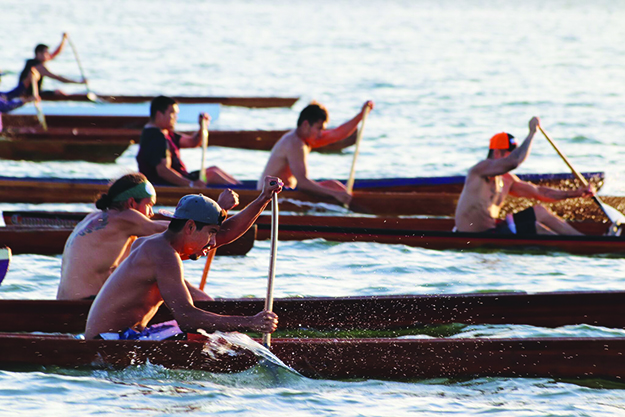
“Hell of a race,” exclaimed the first place racer as he shook the hands of the second and third place pullers. “It was a close one. It was fun though, great pulling out there!”
Over the weekend of June 8-9, several Coast Salish canoe families gathered at Tulalip Bay for the annual War Canoe Races. The popular two-day event attracts hundreds of Native pullers every year. Participants of all ages competed in a number of contests throughout the weekend including singles, doubles, 6-man and 11-man races. Many Coast Salish tribes, bands and canoe families were well represented during the event as they rapidly pulled through the Tulalip Bay waters for a chance to take home first place trophies and bragging rights until next year.

“This is our first time coming to Tulalip and it’s very peaceful here, it’s a really awesome setting,” said racer, Justin Williams. “I’ve been racing since I was a little boy because it’s been a tradition that has been carried on from great-grandfather to my grandfather to father to me, and I’m now bringing it to my children. I love the family time we’re able to spend together while racing. It’s a great event and I look forward to racing here in upcoming years.”
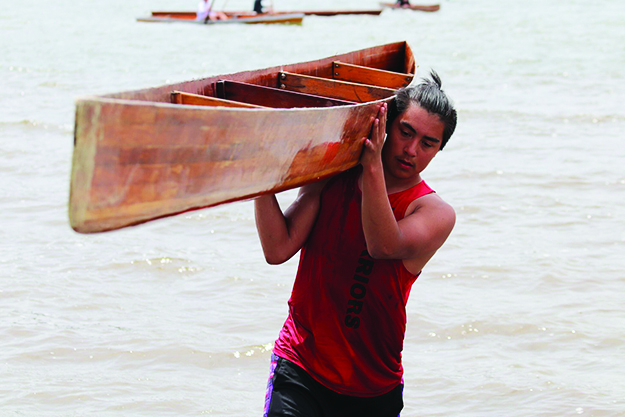
War canoes are built for speed and are much lighter and narrower compared to traditional cedar dugout canoes. As you may know, canoes are an integral piece to the Northwest Indigenous culture and were utilized to travel to gatherings as well as for fishing and whaling trips for centuries. The canoes used for racing, however, were developed during intertribal warfare as a way to raid each other’s villages. As time passed, the canoes became used for the traditional spectator sporting event that has been passed down within tribes for several generations.

Today, canoe families travel from tribe to tribe every summer, competing in a circuit of war canoe races. The races made a return to Tulalip during the warm months of 2015 after nearly a thirty-year hiatus. Each year the event continues to garner large participation, and the bay has become a favorite course on the circuit amongst the racers.

“We would like to thank the Tulalip Tribes and the race committee for hosting us year after year and inviting all the canoe families to share your beautiful bay,” stated Lona Johnson of the Rikkole Cree Canoe Club. “We paddle to uplift our families and our communities; we paddle for healing and to keep our canoe way of life alive. I think it’s important to keep our canoes on the water because it helps our people live a healthy lifestyle and gives us a healthy outlet. The number one rule is to always have fun and that’s what we strive to do; lead by example, go out and do the best we can and always have fun.”
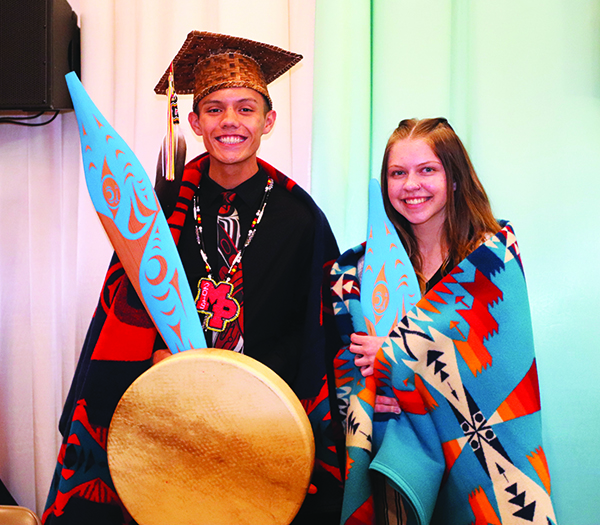
By Micheal Rios, Tulalip News
The Marysville Getchell jazz band kicked-off the event by providing an upbeat mood while guests made the most of a whimsical photo booth setup, chatted with familiar faces and made their way to designated tables.
“Welcome to the 2019 graduate banquet!” opened emcee, Rochelle Lubbers. “We are so happy to have you all in Tulalip, in the heart of our community, on this special night to celebrate our students.”
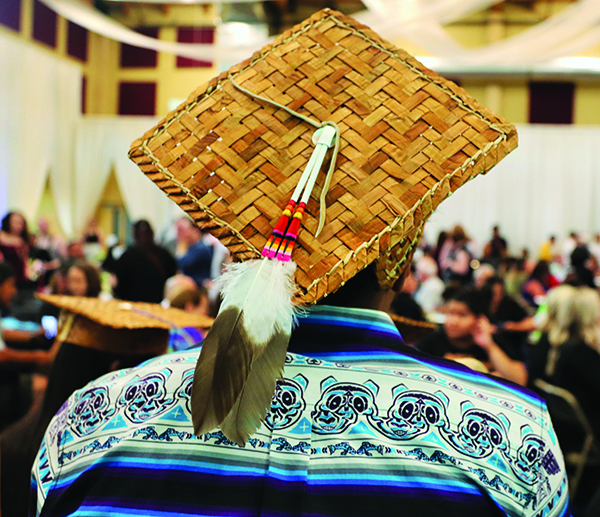
“Your community, your tribe, and your families are so proud of you all,” added Chairwoman Teri Gobin. “As you take your next step on your journey, whether it’s a path towards college or work, your tribe is here to support you. We look forward to seeing what path you decide to take, who you choose to become, and how you can impact our community. My hands go up to each and every one you.”
Fittingly appropriate for the moment, Tulalip drummers and singers performed a song about remembering you are and where you come from. Then mother-daughter duo Deborah Parker and Kayah George offered a song representing the resilient blackfish.
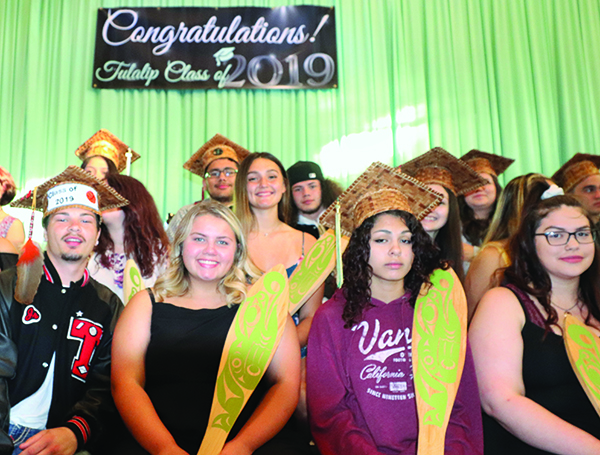
“Our Tulalip Tribes symbol is the blackfish, or the orca. It represents endurance, strength and determination to make it through tough waters,” explained Deborah. “Looking out into the sea of graduates, that’s what I see. A pod of blackfish with that determination, that strength to navigate tough waters and make it here tonight to celebrate an amazing achievement.”
Graduating high school seniors Arnold Reeves and Kordelle Hammons each took to the podium and offered encouraging words to their fellow graduates. They reminisced over their favorite school experiences, spoke of hardships overcome, thanked their families and Tulalip community for always supporting them, and shared their excitement for great things yet to come.
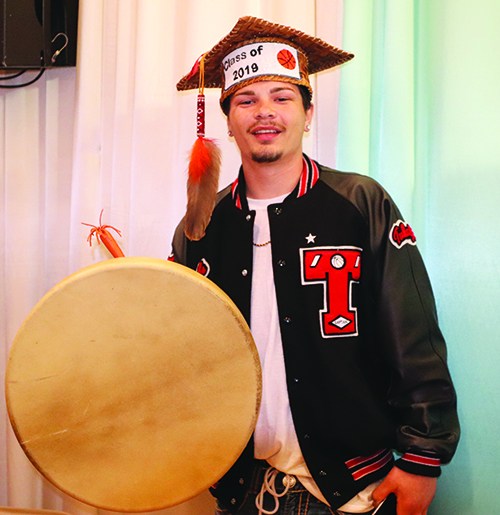
“I believe we are all prepared for what’s to come next in our journeys, which is to become what our elders and ancestors have taught us to believe since kids – that we are the next great explorers, doctors, scientists, and athletes,” said Arnold, graduate of Marysville Pilchuck High School. “We have shown our young siblings, cousins, nieces and nephews that graduating high school is not only possible, but is important for growth and character development. We were once future leaders of tomorrow, but now we have become leaders of the present.”
Becoming leaders of the present may seem like a daunting task to most 18-year-olds who have grown accustomed to a daily consistency and structure provided by their k-12 education. However, for Indigenous youth, they’ve been bucking the trend and blazing new paths to educational success for years now without even realizing it. They’ve beaten the odds that said they would never graduate high school and overcome obstacles that could have easily taken them off their path.
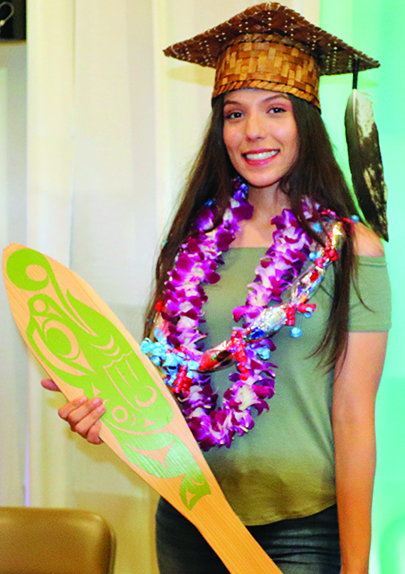
For some students, their education and high school diploma meant not only proving everyone wrong, but also meant earning independence and the opportunity to find happiness in a world of their own creation.
“High school didn’t mean much to me following the MP shooting, but then I realized I had to make my friends that are still here proud,” shared Paul Shay, Jr. A graduate of Heritage High School who, after a rough start refocused his energies on a family of friends and sports, made 1st team All-State in basketball and now wants to become a psychologist to help tribal youth. “The journey I took through high school was very different than most other people. I’ve been through every struggle you can go through and survived to come out on top. My message to the youth is to never give up, no matter what. Always keep pushing and keep trying because at the end of the day living your best life is worth it.”
Following an inspiration keynote speech by Nooksack Councilmember Katherine Romero, the high school seniors reminisced one last time while the memory-filled graduate video played on the big screen project. The graduates then strutted with pride down a red carpet to the loud applause of all in attendance.
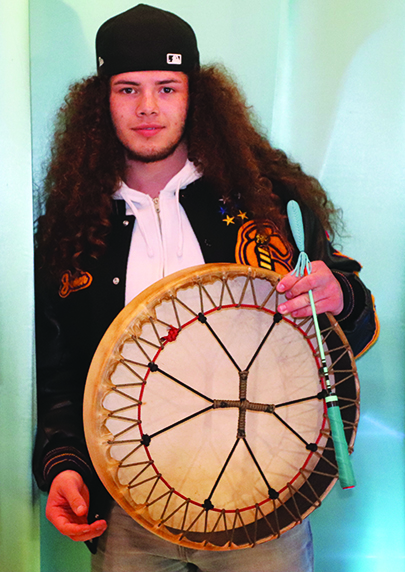
Each graduate shook hands with Indigenous Education liaisons and Marysville School District representatives while walking across the stage to be presented with distinctive cultural items. The boys were gifted drums made by Adam Jimmy and Ryan Martin, while the girls received hand-made paddles courtesy of artist Ty Juvinel.
Special honorariums included the highly coveted Tulalip Tribes senior boy and girl of the year award.
Kiley Lakins, a graduate of Marysville Getchell, received the female student of the year honor. Having overcome adversity early on as a freshman, Kiley went on to challenge herself with AP courses in Language Arts and Literature during her upperclassman years. She helped her peers and community by volunteering at the Marysville food bank, Warm Beach events, and through peer tutoring. Her teachers described her as always demonstrating an incredible work ethic and constantly holding herself to a high standard. After getting a 4.0 for her entire senior year, Kiley finishes high school with an impressive 3.6 grade point average. She plans on attending the University of Washington in the fall.
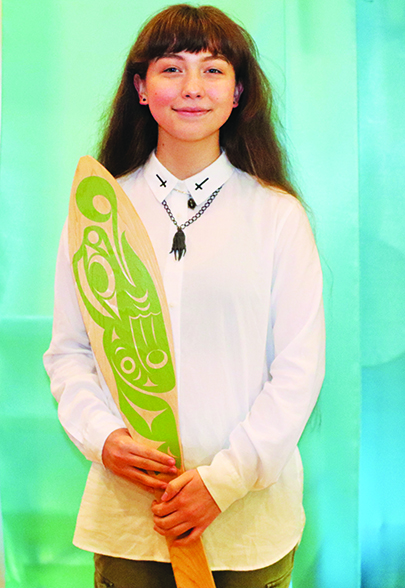
“I really struggled my freshman year, but I refused to give up,” reflected Kiley. “Now, I’m looking forward to the UW and pursuing a degree within the social sciences. Thank you for everyone who has believed me and encouraged me to always try my best.”
Kordelle Hammons, a graduate of Marysville Pilchuck, received the male student of the year honor. He was noted as taking advanced or honors level classes since middle school and always excelled. One teacher said, “He has proven to be a positive role model for others and has constantly demonstrated sincere desire to use his individual talents and abilities in service of those around him.” Kordelle is looking forward to a 6 ½ year medical program at American University of Antigua (in the Caribbean) where he can earn his Associates, Bachelors and Medical degrees.
“My elders and parents have always told me that when you go to college, go far, because the reservation will always be here for you when you come back. When you come back bring the knowledge you have been given and give it back to your people,” shared Kordelle. “This is something I hope to do by becoming a surgeon and coming back to the Tulalip Reservation.”
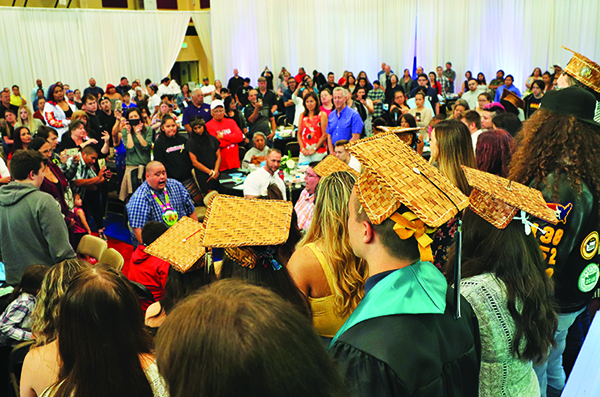
Congratulations to all those Tulalip students who put in the hard work and dedication to earn their high school diploma. Chasing a dream requires your efforts and passion. The hard work isn’t over now that you have graduated, it’s just the beginning as you now prepare for the new challenges waiting in the next chapter of life. Good luck and congratulations!
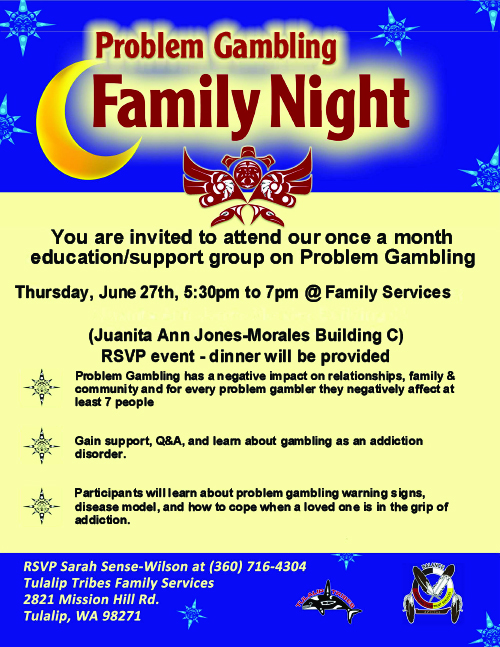
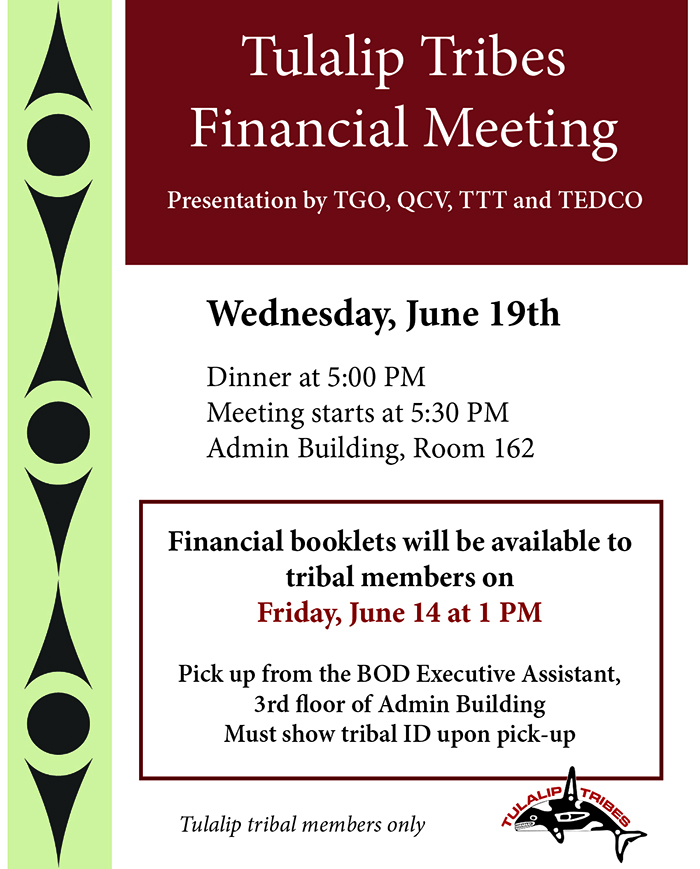
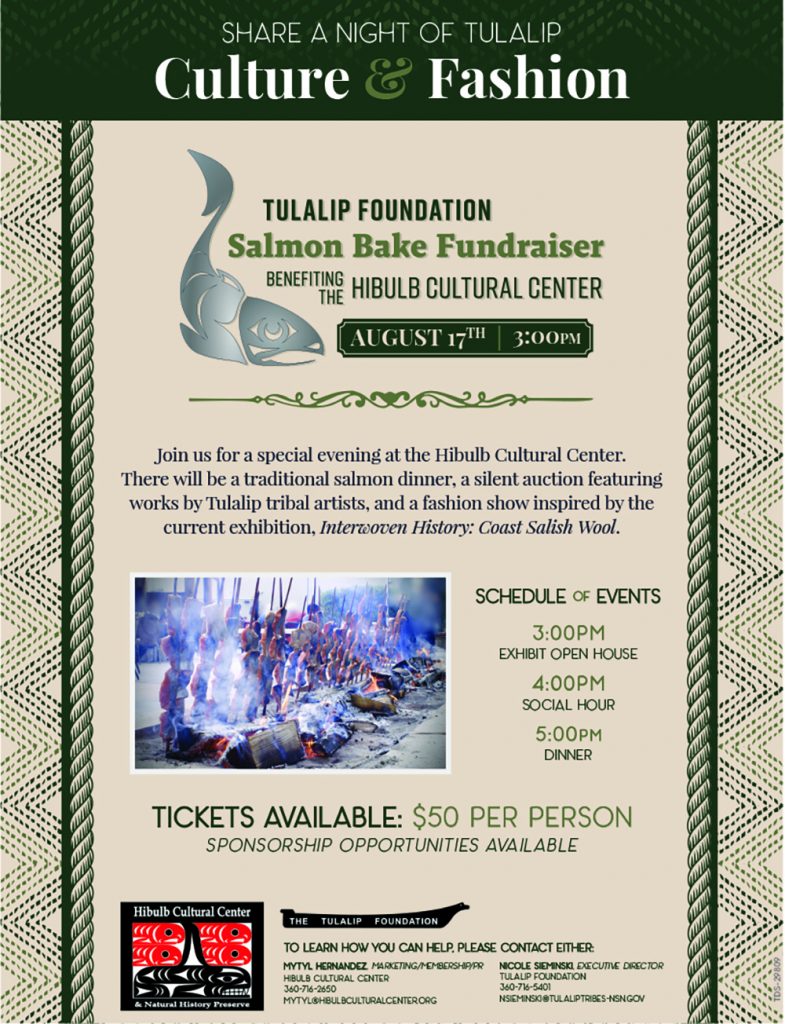
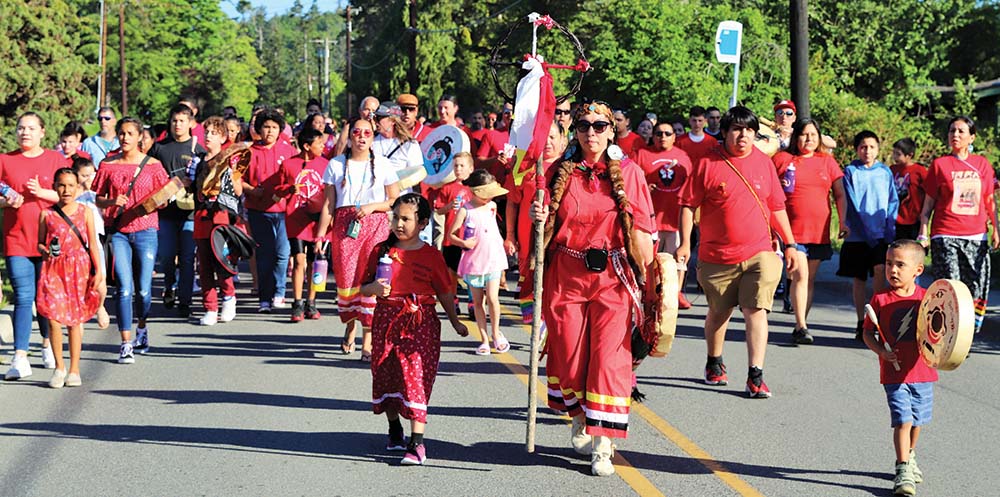
By Micheal Rios, Tulalip News
“It is an honor to be here today. We raise our hands to the Tulalip Nation for welcoming us,” said Earth-Feather Sovereign (Colville Confederated Tribes). “We are here in honor of our missing and murdered Indigenous women and girls, and all missing and murdered people, including two-spirits. We are here to bring community together and to hold a space for healing and awareness.”
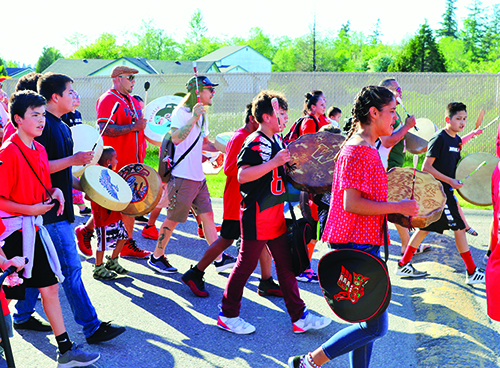
Earth-Feather’s opening remarks struck a chord in every one of the nearly two-hundred Tulalip citizens and community members who gathered at Greg Williams Court on May 10th for an evening of unified support. The vast majority of supporters wore red to symbolize the violent dangers faced by many throughout Indian Country. Numerous reports detail the severity in which Native American women face a disproportionate amount of violence, and the degree to which victims’ cries are silenced, when compared to others in the United States.
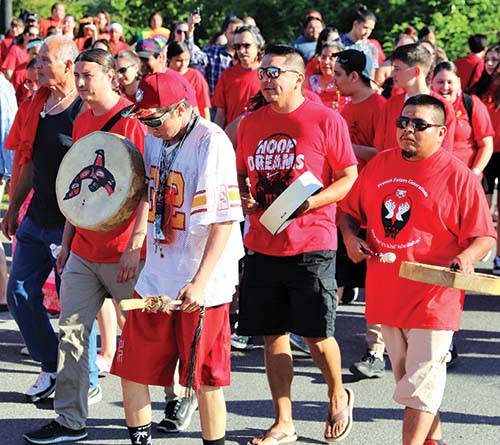
The National Crime Information Center reports that, in 2016, there were 5,712 reports of missing Indigenous women and girls, though the U.S. Department of Justice’s federal missing persons database only logged 116 cases. The Center for Disease Control and Prevention has reported murder is the third-leading cause of death among Native American women between the ages of 10 and 24, and rates of violence on reservations can be up to ten times higher than the national average.
The Tulalip Tribes hosted the sixth stop of an eight city journey from Olympia to Blaine, organized by Earth-Feather and the MMIW Washington group to further awareness for all missing and murdered Indigenous people. Supporters of the cause were greeted at Greg Williams Court and given a red t-shirt that read ‘Prayer Walk 2019’ along with a special cedar rose wrapped in red ribbon to commemorate the occasion.
After a welcoming, prayer, and drum circle set the mood, the large contingent of red-wearing community members began their march through Tulalip. Led by the Sacred Riders, the crowd resembled a sea of red as they walked from Tulalip Bay to the Battle Creek neighborhood.
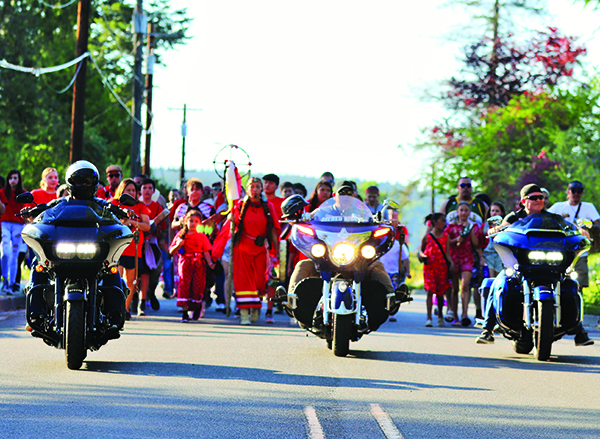
“Our Sacred Riders motorcycle club was honored to be here today and support this important cause,” explained Tony Hatch. “The organizers welcomed us and our motorcycles because it draws more attention to the march itself, and we’re able to lead the way by keeping the road clear for the marchers and their prayers.”
During the march, many prayers were offered for anyone in need, songs were sang to keep spirits uplifted and tobacco was dropped to honor spirit helpers. It was a powerful demonstration made possible only through a strong sense of purpose and shared mission.
“This march means raising awareness for our Native women. The ones who have been murdered or gone missing,” shared Winona Shopbell-Fryberg as she walked alongside her father and daughters. “I was taught how sacred our Native women are, that we are the life givers of our people. When these things happen to our women, along with the domestic violence, it’s very disrupting to our way of life.”
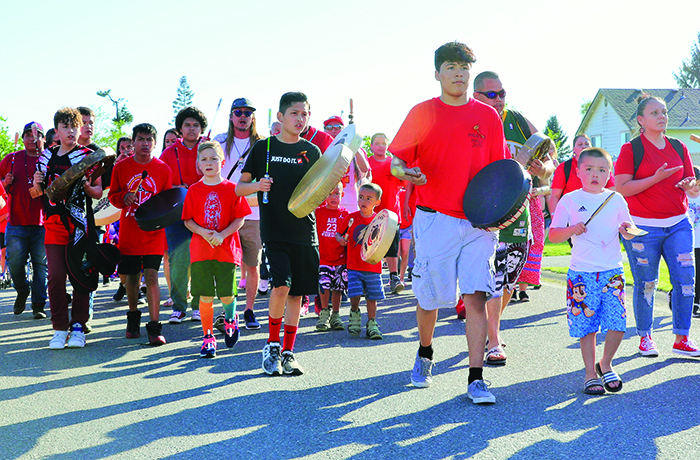
“There’s a lot of us doing our work in our own lives, but we don’t often come together,” added Bibianna Ancheta while taking in the moment. “We’ve been trying and trying to unify our people. This has been a long time coming, a good opportunity for our people to come together.”
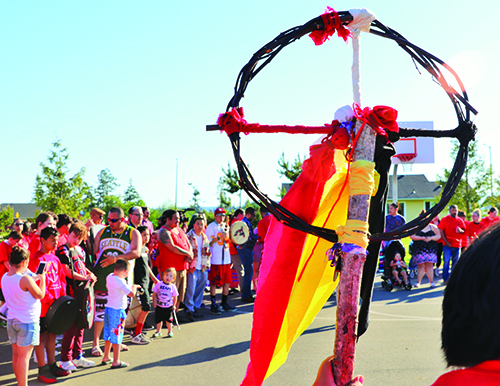
Deep, rhythmic drumbeats from the march could be heard all around the bay. Many people stood outside their houses to take in the scene, while others felt the calling to join in. The distinctive sound acted like a locator beacon for those drawn to the drum, like Monie Ordonia who hopped in her car and followed the sound to the march.
“I was in my bedroom and heard loud drums. I wondered what was going on, so I jumped into my car and drove down Marine until I saw all the red,” she described.
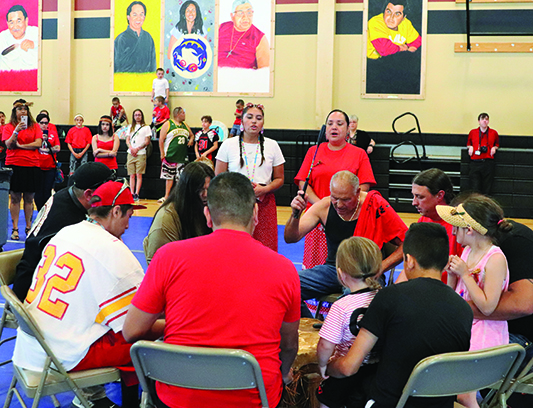
The march continued to the Battle Creek park, where the group formed a large prayer circle and dropped more tobacco, before heading back to Greg Williams Court. Earth-Feather greeted every single participant as they entered the gym with a handshake and thank you.
Back at the gym, a delicious dinner was served followed by a coastal jam.
“It’s amazing that as a community we’re coming together to embrace one another, to support a movement and help bring a spotlight to an issue that for far too long has only received a blind eye,” said Jade Carela, Legacy of Healing Director. Jade and Josh Fryberg, on behalf of the Tribe, presented MMIW Washington with a donation to help further their cause as the group makes their way to the international Peace Arch situated near the Canadian border.
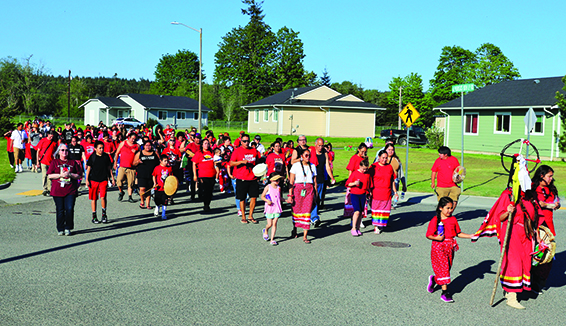
“We’ve really enjoyed the Tulalip hospitality and felt so much love today with our march,” reflected Earth-Feather at the event’s conclusion. “This isn’t something that only happens in the Pacific Northwest, it’s a pandemic happening to all our Indigenous people across Turtle Island. Bringing prayers and resolutions to the issue, while raising continued awareness to missing and murdered Indigenous women, creates protection now and for generations to come.”
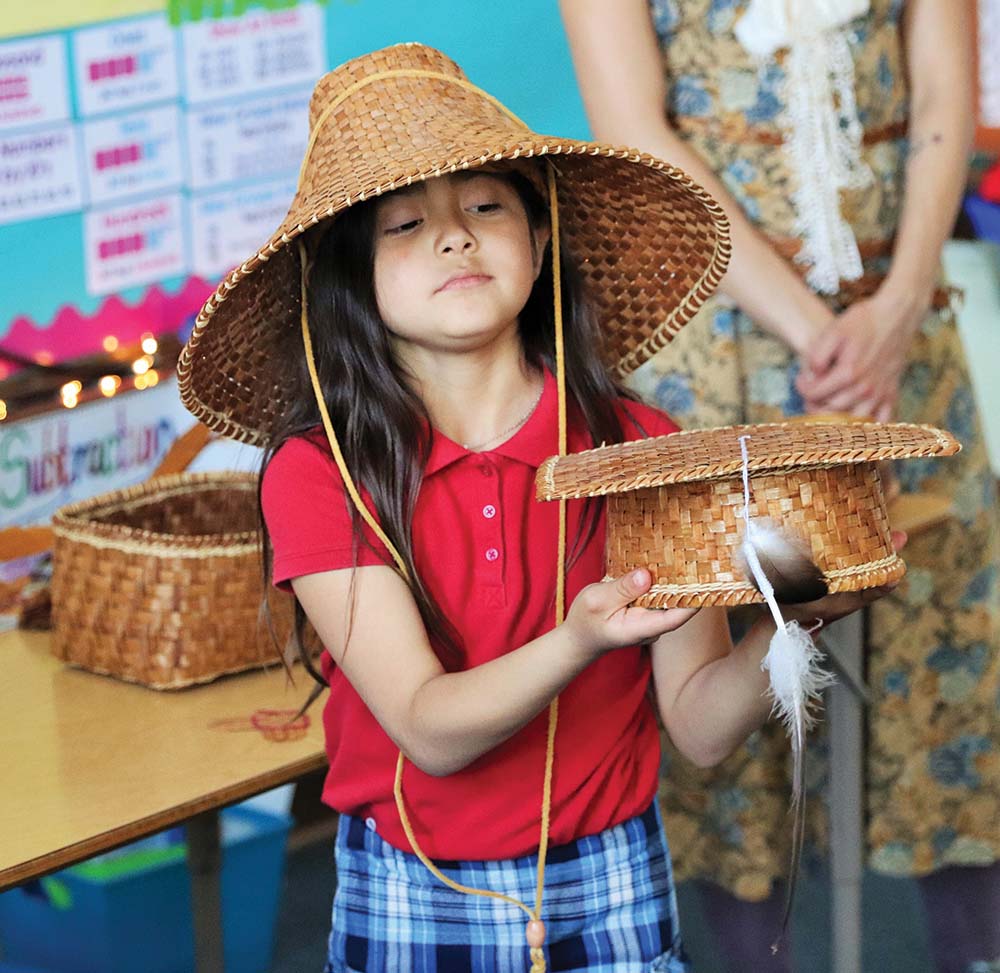
By Micheal Rios, Tulalip News
During a recent in-class lesson, 2nd grader Tiyanna Bueno sat at her desk inside Immaculate Conception Catholic School reading about a Native American rug weaver from New Mexico. Suddenly, inspiration struck the 8-year-old Tulalip tribal member and she yelled out excitedly, “My mom is a weaver! She weaves with cedar.”
A dash of persuading here, some finagling there, and Tiyanna had whipped up an hour-long session for her mother Malory Simpson and Lushootseed language teacher Maria Martin to be guest presenters in her Everett classroom. The idea was to teach the 2nd grade class about local Native American culture while giving a cedar weaving lesson in the process. Fancy that: actual Tulalip culture taught by actual Tulalip educators.
“We want our Native kids from Tulalip to feel like they are represented as an important part of our school,” explained 2nd grade teacher Mrs. Hegg. “Our school’s values are enhanced by promoting the cultures of our students. It’s vibrant, it’s beautiful and goes well with our shared teaching to be good stewards of the Earth.”
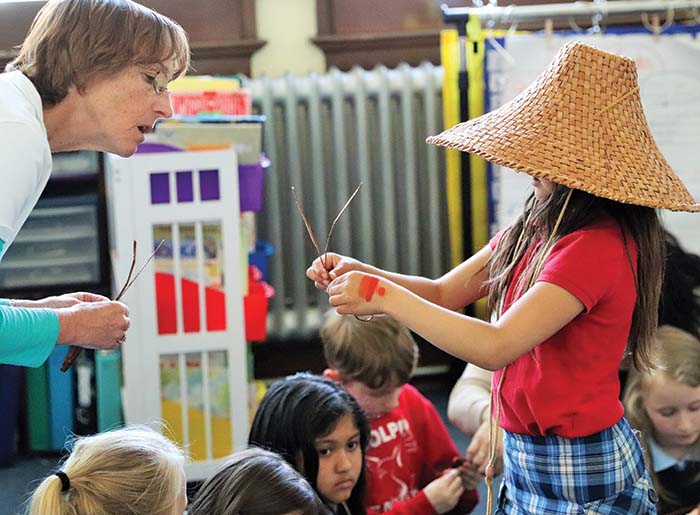
So on a Friday afternoon in early May, Tiyanna, wearing a traditional cedar hat, beamed with pride as she introduced her fellow students to their special guest presenters. Malory and Maria brought in a treasure trove of cedar along with their life-long experiences from being Tulalip citizens.
“We come from the Tulalip Tribes, live on the Tulalip Reservation, and wanted to talk to you all about cedar and what it means to our culture,” said Miss Maria. “I’ll be reading the story Her First Basket. If you listen carefully, you’ll come away with a few lessons that are meaningful to us.”
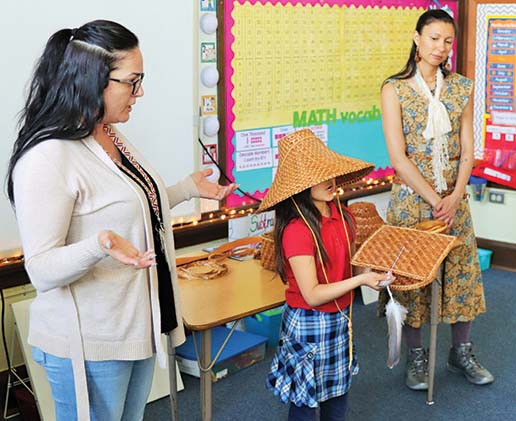
Coast Salish tribes believe the Creator gave their people cedar as a gift. Traditionally, a prayer was offered to honor the spirit of the tree before harvesting its bark, branches and roots. Their ancestors taught them the importance of respecting cedar and understanding how it is to be used, so it will be protected for future generations.
Cedar was the perfect resource, providing tools, clothes, baskets and carvings in addition to having medicinal and spiritual purposes. The highly sought after golden inner bark is separated into strips or shredded for weaving. The processed bark is then used like wool and crafted into clothing, baskets and hats.
Those same traditional teachings are practiced today, along with many others, and passed down to the next generation. While Malory and Maria shared their stories and personal experiences through cedar teachings to the attentive group of youngsters, an ecstatic Tiyanna embodied the spirit of her ancestors by not being afraid to express herself culturally and modelling a variety of cedar creations.
Traditional knowledge was shared and memories made, especially when the trio of Tulalip culture bearers gave a hands-on lesson via cedar rose making. They not only received 100% participation from the students during the activity, but after explaining its tradition to give away your first creation, the 2nd graders quickly got to work making a second and, in some cases, even a third cedar rose.
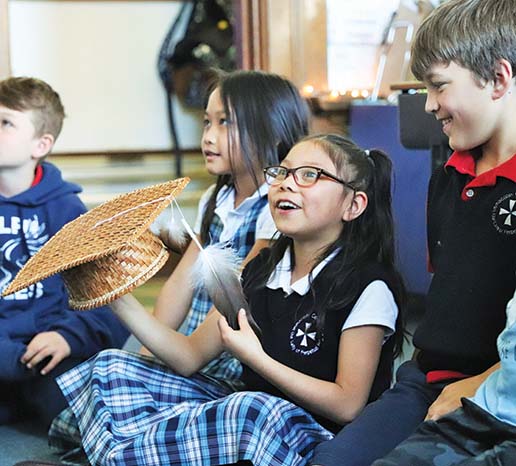
“[Cedar] smells like nature’s perfume,” described one eloquent kiddo. While another quick learner insisted, “Cedar roses are better than real flowers because those die. These ones will live for 1,000 years!”
A definite highlight was when the students asked how to say ‘cedar’ and ‘thank you’ in Lushootseed. After getting the pronunciations down, they were heard using their learned Lushootseed over and over again amongst each other.
“It felt so good to be able to share a piece of our culture,” said Miss Malory, Native Education Advocate. “It makes my heart happy to see the students being so welcoming and eager to learn about another culture. Tiyanna is such a free spirit and takes pride in being open to share about herself, her family and our culture.”
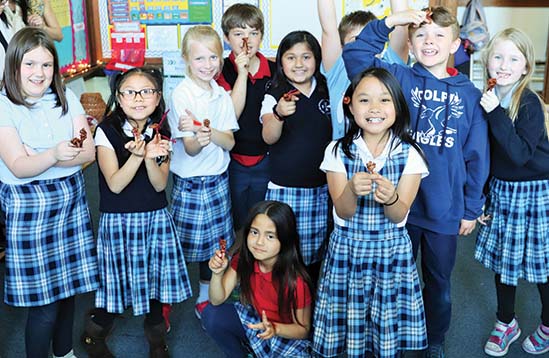
Reflecting on an afternoon she got to bring her Native American lifeway into the classroom, 8-year-old Tiyanna shared, “My favorite part was showing off the cedar hats, cedar headbands, and a cedar heart. I liked showing these things to my class because they remind me of my home in Tulalip.”
Mrs. Hegg’s 2nd grade kids received hands-on teachings with cedar weaving, learned how to say ‘cedar’ and ‘thank you’ in Lushootseed, and, most importantly, learned about a local Native culture not from a textbook, but by living, breathing Tulalip educators.
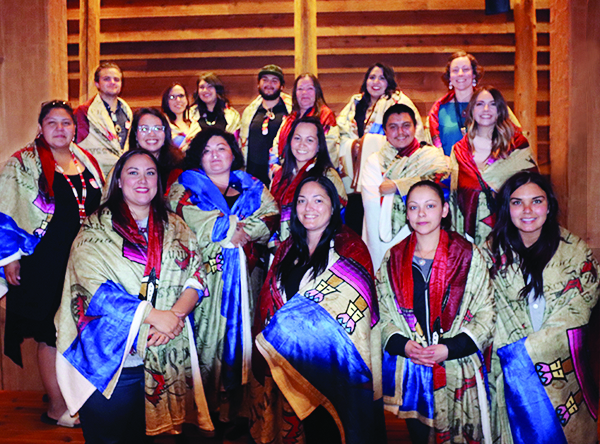
By Micheal Rios, Tulalip News
“Every single time a Native graduates, it’s an opportunity to rewrite history. Because for so long we were shut out of environments where we could tell our own stories,” explained renowned author and keynote speaker Gyasi Ross. “This is a powerful moment. The work you’re doing is recapturing our narrative, its reclaiming our story. You all have counted coup on an educational system that wasn’t created for us. That deserves an amazing amount of acknowledgement and respect.”
Gyasi’s sentiments were well received by the class of 2019 higher education graduates during a special banquet held in their honor on May 20 in the Hibulb longhouse. Surrounded by their supporters in an atmosphere of accomplishment, thirty-five graduates received a heartfelt ovation as they walked proudly to the front when their name was called. Vibrant Native Anthro blankets and silver pendants made by local artist Al Charles were gifted to each honoree to commemorate the occasion.
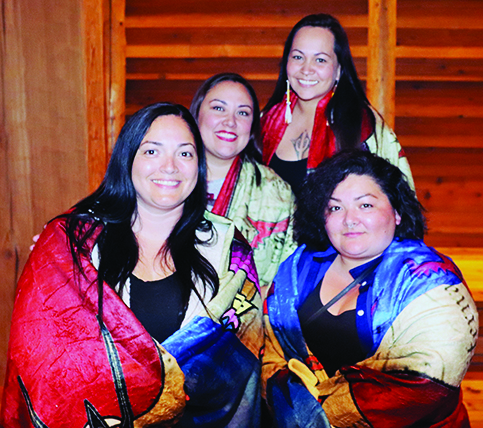
When it comes to being Native American and educated, the common narrative is Natives can’t succeed in a westernized education system. U.S. Census data shows that while more than 60% of high school students go to college, only 17% of Native students are able to continue their education after high school. In a time where education is an important cornerstone for self-sufficiency and quality of life, only 13% of Natives age 25 and older hold a college degree. That narrative is being rewritten by Indigenous scholars who are actively working to decolonize education pathways, not just for themselves but for generations to come.
“My journey started when I had my oldest son, Preston, and I knew that the current education system wasn’t one he should have to go through,” shared Western Governors University graduate Brianne Distefano. “My goal was to create change from within, so I went to work at Quil Ceda Elementary as a para-pro. Now, I’m the Native Liaison. I believe we need as many Native educators as we can get in the school systems because for our kids to be able to dream big, we need to break the mold.”
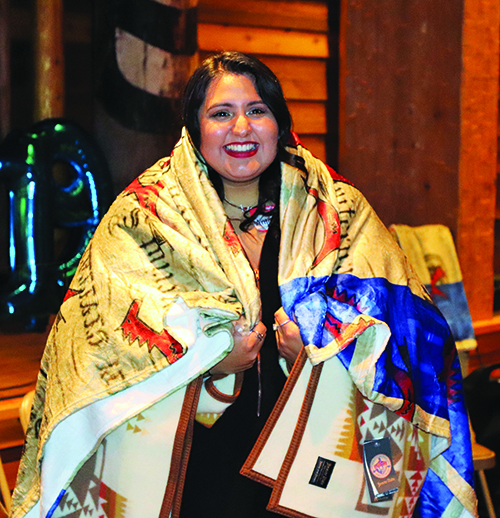
The class of 2019 higher education grads includes 7 Associate’s degrees, 13 Bachelor’s degrees, 2 Master’s degrees, and one of the most coveted achievements in the academic world, a PhD.
“Essentially, I have spent the last 29 years off and on working towards my PhD,” said newly dubbed Dr. Lena Hammons. “Our history gave us some truly amazing tribal leaders, their struggles, survival, and resilience made them strong. Our ancestors’ stories make our people stronger and the more educated we become helps us to fight the political battles we face every day.”
It’s a longer, tougher road for Native adults pursuing their education, which is all the more reason to celebrate their accomplishments. Sometimes there are even more perilous obstacles on the path to success, like battling addiction.
“I was in active addiction while going after my GED,” admitted Everett Community College graduate Aaron Pablo. “Something my journey has proved is it doesn’t require someone being clean and sober to put in the work and get educated. I put in the work, reached my goal, and then put my sights on getting clean. Now, I have 4 months and 25 days clean.”
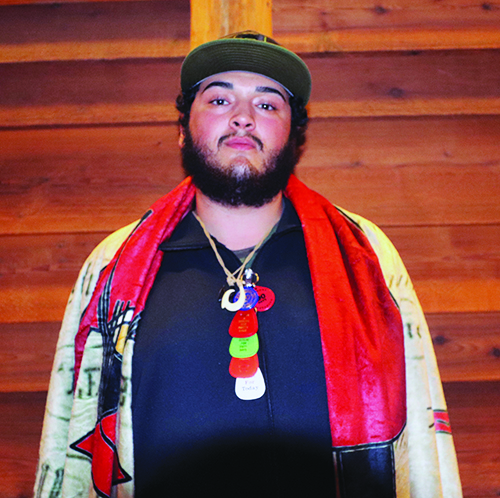
Results of dedication from a lot of long nights and hard work prove what is possible for aspiring Native students everywhere. Fortunately, the Tulalip Tribes offers additional support for prospective and current students via the Higher Education Department and a network of individuals committed to helping. During the evening’s banquet, Valda Gobin, Dawn Simpson, Jeanne Steffener, Norma Comenote, and Margarita Houston received special recognition.
“These ladies were recognized for all of their hard work and care that they put into each student, client, and community member that they serve each day,” said Felicia Stripling, Higher Education Coordinator. “They put their heart and soul into their work and it shows. We wanted to show our appreciation for them and all that they do for our community.”
Tulalip’s Higher Education staff are eager to help new and returning students find their path to success. They can assist with FAFSA and finding scholarship opportunities, while also helping students choose the right school based on personal interests and career desires. For those tribal members who are empowered to continue rewriting the narrative, please contact Higher Education at (360) 716-4888 or email highered@tulaliptribes-nsn.gov
By Kalvin Valdillez, Tulalip News
For the past ten holiday seasons, Subaru dealerships across America collectively raised over $140 million dollars during their annual Share the Love campaign. The event is held during the months of November and December in which the company pledges to donate $250 for each new Subaru sold or leased to a charity selected by the dealership.
Previously, the dealership’s choices were between the National Park Foundation, the American Society for the Prevention of Cruelty to Animals (ASPCA), Meals on Wheels and the Make-A-Wish Foundation; resulting in the protection of over 100 National Parks, the rescue of over 50,000 animals, the preparation of over 2 million meals for seniors nationwide and over 1,800 wishes granted to youth battling life threating illnesses. In 2013, Subaru added a fifth option, affording their dealerships the opportunity to donate to a local charity or non-profit of their choice. After much consideration, the friendly crew at Marysville Roy Robinson Subaru decided to donate their 2018 Share the Love earnings to the Tulalip Foundation.
The Tulalip Foundation is a non-profit organization that is dedicated to empowering the wellbeing of the Tulalip reservation and its surrounding communities. Since 2007, the Foundation has worked with a number of programs to create a brighter future for the Tribe, programs that are based on three important values to many tribal families: culture, education and justice.
Originally, the Foundation began as a way to raise the last remaining million dollars needed to open the Hibulb Cultural Center. Since the museum’s opening, the non-profit has raised money, accepted donations and applied for a number of grants to provide several programs and departments with the funds for events, incentives and services including the Betty J. Taylor Early Learning Academy Parent Committee, Tulalip Office of Civil Legal Aid (TOCLA), Tulalip TERO Vocational Training Center and the Tulalip Veteran’s Quilt Project. The Foundation also hosts a number of fundraisers throughout the year such as the Hibulb Cultural Center Salmon Bake and their annual Giving Tuesday event.
Last November, Roy Robinson Subaru General Manager Robb McCalmon stated his crew would be hard at work during the holiday season in hopes of delivering a ‘big check’ to the Foundation come springtime. On the morning of April 15, Robb and his team did just that by presenting an oversized check to the Tulalip Foundation Board of Trustees – a grand total of $21, 149.
The Share the Love event helped improve an already strong relationship between the local Subaru dealership and the Tribe, as well as spread the message about the good work the Tulalip Foundation is doing for the community. Over the next few months, the Foundation will convene and discuss which programs to distribute the donation to, ensuring the efforts made by the Roy Robinson crew are well spent.
“The Tulalip Foundation was extremely honored to be chosen as Roy Robinson Subaru’s community partner for their 2018 Share the Love event,” expresses Tulalip Foundation Executive Director, Nicole Sieminski. “It was a unique opportunity to share our work with the greater community and their generous donation will do a lot of good work in the Tulalip community.”
For more information, please visit Marysville Roy Robinson Subaru or contact the Tulalip Foundation at (360) 716-5400.